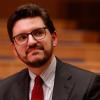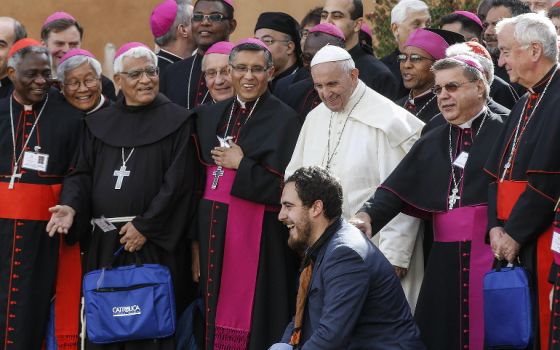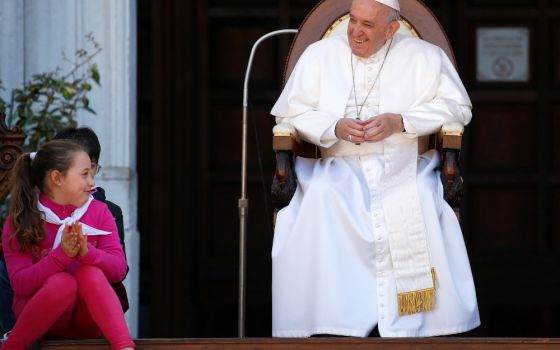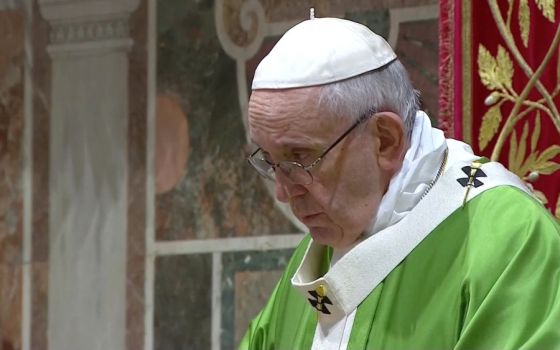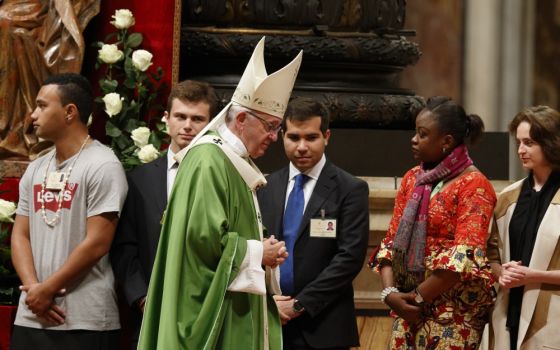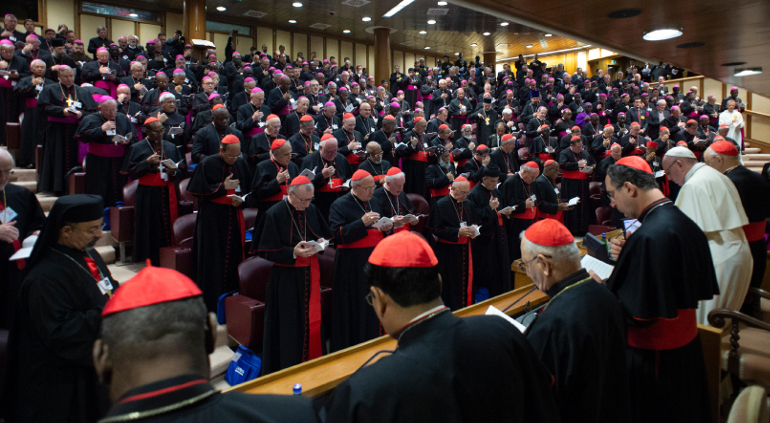
Pope Francis attends a session of the Synod of Bishops on young people, the faith and vocational discernment at the Vatican Oct. 4. (CNS photo/Vatican Media)
A worldwide gathering of hundreds of the Catholic Church's prelates ended Oct. 27 with the issuing of some of the global institution's strongest language yet for the inclusion of women in its all-male decision-making structures, calling the matter a "duty of justice" that requires a "courageous cultural conversion."
Although the final document from the Oct. 3-28 Synod of Bishops does not mention women's ordination — neither to the priesthood nor to the diaconate — it acknowledges that women have been excluded from decision-making processes even when they "do not specifically require ministerial responsibility."
"The absence of women's voices and points of view impoverishes discussion and the path of the church, subtracting a precious contribution from discernment," it states. "The synod recommends making everyone more aware of the urgency of an inescapable change."
A 60-page text that was the fruit of intense discussions among 267 male prelates and 72 lay auditors at the month-long synod gathering, the document however softens an earlier draft's language regarding the ongoing clergy sexual abuse crisis, retreating from a promise that the Catholic Church would practice "zero tolerance" on the issue.
Where the first draft, presented to the synod participants privately Oct. 23, had five paragraphs devoted to clergy abuse, the final version has three. Instead of the original reference to "zero tolerance," the final version says the synod "reaffirms the firm commitment for the adoption of rigorous measures of prevention" of abuse.
The final text says that revelations of abuse have become a "serious obstacle" to the fulfillment of the church's mission, and admits that many abuse cases have been handled in a manner "lacking responsibility and transparency."
The synod text also retreats on the issue of the church's ministry to gay people, both refraining from repeating the Vatican's earlier first use of the acronym LGBT and replacing the first draft's condemnation of violence based on "sexual orientation" with one against "sexually-based violence."
"The synod reaffirms that God loves every person and so does the church, renewing its commitment against every discrimination and sexually-based violence," states the final document.
"Equally reaffirmed is the determinative anthropological importance of the difference and reciprocity between man and woman and it is held to be reductive to define a person's identity only by their 'sexual orientation,'" it states, citing a 1986 document from the Vatican's Congregation for the Doctrine of the Faith.
Although the discussions leading to the changes between the draft and final document of the synod took place behind closed doors, it is known that the synod bishops — who have come to Rome from every part of the world — submitted hundreds of proposed amendments to the first version of the text.
In past synods, changes to draft texts have sometimes come about in an effort to ensure the documents pass the vote threshold for their approval, which is two-thirds of the synod members present at the time of the tally.
Voting on the 2018 document took place late Oct. 27, with the prelates giving each paragraph of the text a simple yes or no. All of the 167 paragraphs of the document were adopted by the assembly with the required two-thirds: 166 members of the 249 present for the voting.
The closest margin came on one of the paragraphs dealing with the church's ministry to gay people, which received 178 yes votes.
While bishops had not spoken publicly about what specific language they were considering regarding the abuse crisis, several prelates had addressed the issue of whether the synod would make reference to the LGBT acronym.
In an Oct. 25 NCR interview, Indian Cardinal Oswald Gracias said there had been "strong reservations" expressed among bishops in the synod hall about using the term.
"Some were saying we don't even know what it means and you're thrusting this on us," said Gracias, the archbishop of Bombay and one of 12 synod members selected to serve on the committee that drafted the final document, and then incorporated the proposed amendments.
"The voices against it were quite substantial," said the cardinal, specifying that the term "was not seen as neutral."
"There were some who felt that using the term means giving recognition and acceptance," he said, before adding that there was also a "general feeling" that "pastoral attention involves everybody; we cannot close anybody out."
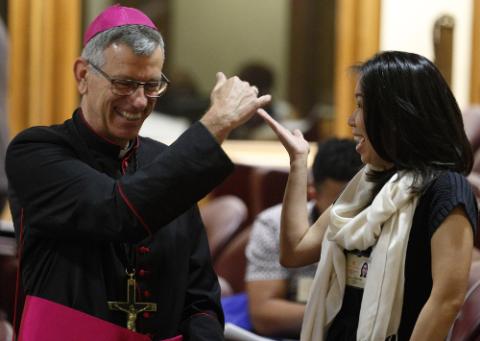
Auxiliary Bishop Mark Stuart Edwards of Melbourne, Australia, shares a laugh with Indonesian youth delegate Anastasia Indrawan before a session of the Synod of Bishops at the Vatican Oct. 9. (CNS photo/Paul Haring)
This Synod of Bishops, focused on young people, did not attract as much global attention as the last two synods, which were held in 2014 and 2015.
Those earlier gatherings both focused on issues of family life, and led to Pope Francis' 2016 apostolic exhortation Amoris Laetitia, which softened the Catholic Church's stance toward the divorced and remarried.
But participants of this year's gathering — which in a first included about 30 young people alongside the hundreds of prelates from the various continents — have said the discussions were notable for their open and diverse nature, including conversations about a wide range of topics.
The final document, issued in Italian late in the evening in Rome Oct. 27, likewise tackles a great range of issues.
Starting with considerations on how the church can better serve young people as they face a host of new challenges in the 21st century, the text then examines how the church itself might change to make room for more diverse and youthful leadership.
Picking up one of the central themes Francis' five-year papacy, the document ends with a call for the church to become more "synodal," referencing a Greek root that means to "walk together" and possibly indicating a future move towards decentralization and more sharing of authority between bishops and laypeople.
As the text says, a "synodal" church would be "participative and co-responsible … welcoming with gratitude the contribution of lay faithful."
Gracias, who is also the president of the Indian bishops' conference and a member of the Council of Cardinals, said that such a church would involve bishops who can "feel comfortable sharing power."
"Everybody is walking together," the cardinal said of the process, adding: "Because of that, maybe we'll walk slower because everybody is there, but at least we'll have the joy of communion, the joy of taking everybody along."
In brief off the cuff remarks ending the synod gathering, Francis said the meeting had not been a parliament but "a protected space, so that the Holy Spirit can work."
"Let's not forget this," said the pontiff. "It was the Spirit that was working here."
'Epochal' reform on abuse
The synod gathering got underway in early October as Francis was facing intense global scrutiny over his handling of clergy sexual abuse after a former Vatican ambassador publicly alleged a systemic cover-up of allegations against now ex-cardinal Theodore McCarrick.
The daily press briefings during the first week of the synod, which included participants taking part in the gathering's closed-door meetings, frequently addressed clergy abuse.
Australian Archbishop Anthony Fisher, for example, explained that he had used his speech at the synod to formally apologize to young people.
Maltese Archbishop Charles Scicluna focused on a February summit on abuse prevention Francis has asked the presidents of the world's bishops' conferences to attend, saying the issue of accountability for Catholic prelates who mishandle abuse allegations should be on that meeting's agenda.
While the final document retreats on the earlier line of "zero tolerance" for abuse, it says the synod "recognizes that confronting the question of abuse in all its aspects … can truly be an opportunity for reform of an epochal reach."
The question of how the synod would address gay people had been the subject of intense speculation for weeks.
Although the working document for the synod, released in July, had made the Vatican's first use of the acronym LGBT, some bishops had publicly expressed concern about the church formally adopting that language.
Cameroon Bishop Andrew Nkea Fuanya told an Oct. 24 press briefing: "If I go to my diocese with a document saying LGBT ... 99.9 percent will raise their hands and ask me, 'What is that?'"
"We are not solving problems of particular continents," said Fuanya. "We are looking at the church from a global point of view."
The lack of women's leadership in the church had also received unusual scrutiny during the synod.
Outside groups and even some of the synod's members made note of the fact that while dozens of women were taking part in the gathering as auditors and participants, none had been granted full membership and therefore could not vote on the final document.
One particular disparity attracted wide attention: that two non-ordained religious brothers were allowed to serve as synod members, while the seven sisters taking part were not.
According to the Catholic Church's theology, brothers and sisters have analogous roles. They are each non-ordained, professed members of religious orders.
An Oct. 3 protest at the beginning of the synod called attention to the imbalance in the synod's treatment of brothers and sisters, as did a later petition that attracted more than 9,000 signatures in two weeks.
Lasallian Br. Robert Schieler, one of the two brothers serving as a synod member, told NCR in an Oct. 16 interview that the two Rome-based umbrella groups representing members of male and female Catholic religious orders globally are planning to present Francis with a proposal to give women a larger role in future synods.
The first draft of the synod document had contained a reference to the issue, which was removed in the final text.
The initial language had acknowledged that questions regarding women's participation in the gathering had been "raised" in discussion, including the matter of "avoiding the disparity between the representatives of male and female religious life."
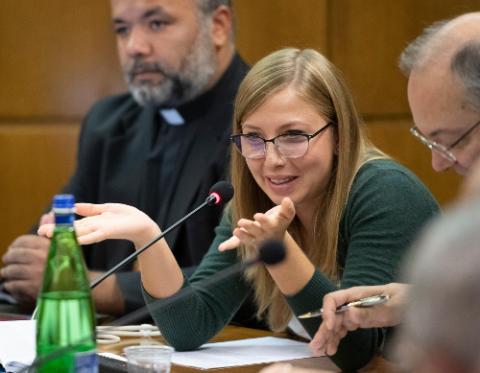
Italian synod observer Federica Ancona speaks during small group discussion at the Synod at the Vatican Oct. 19. (CNS photo/Vatican Media)
Sexual teachings 'a cause of incomprehension'
The synod document unfolds over three parts, following the see-judge-act model.
It opens with a preface that places the synod's considerations in the context of Luke's account of Jesus' first meeting with two of his disciples after the resurrection, when Jesus, unrecognized at first, walked with the men as they went from Jerusalem to Emmaus.
The experience of the disciples at Emmaus, the synod members write in the preface, "expresses well what we have experienced at the synod and what we wish that each of our local churches could experience in their relationship with young people."
"Jesus walks with the two disciples," they state. "[Jesus] speaks to them and is patient in listening to their version of the facts, to help them recognize what they are living through."
The first part of the document is titled: "He walked with them;" the second: "Their eyes were opened;" and the third: "They set out at once."
The three issues of sexual abuse, women, and ministry to gay people are initially raised in the first part of the document and then returned to again in the third, which is largely dedicated to detailing what a church that is more "synodal" would look like.
On abuse, the document makes an apparent reference to survivors, thanking those "who had the courage to denounce evil immediately" and saying they "helped the church become aware of what had happened and of the need to react with determination."
The text then expresses "appreciation" to what it calls the "innumerable" number of Catholics who have served young people "with honesty and dedication." Their work, it says, "is a forest that grows without making noise."
On women's involvement in the church, the document recognizes in its first part that women are often excluded from leadership positions, saying that "in many places it is a challenge to give them space in decision-making processes."
Returning to the issue in its third part, the text says that young people are asking "with great force" for a reflection "on the condition and role of women within the church."
"The reflections developed in the first part [of the text] require realization, through a work of courageous cultural conversion and change in daily pastoral practice," it states.
"An area of particular importance is that of women's presence in ecclesial bodies at all levels, including in roles of responsibility, and of women's participation in ecclesial decision-making processes, while respecting the role of ordained ministry," it continues.
"It is about a duty of justice, which finds much inspiration in the way in which Jesus related with the men and women of his time, and in the importance of the role of some feminine figures in the Bible, in salvation history, and in the life of the church," says the document.
On questions of sexual identity and orientation, the document acknowledges in its first part that some of the church's teachings regarding sexual morality are "a cause of incomprehension" for young people that can lead the church to be seen "as a place of judgment and condemnation."
It then states that many youths want "to discuss questions regarding the difference between masculine and feminine identities, reciprocity between men and women, and homosexuality."
After calling for deeper theological and anthropological study on such matters in its third part, the text says the synod recommends "supporting … ways of accompaniment in faith of homosexual persons."
"In this way, every young person is helped — no one excluded — in integrating their sexuality into their personality, growing … in the path towards the gift of self," it states.
Advertisement
A church that 'shines for its authenticity'
A wide range of other topics are touched upon in the synod document.
The first section speaks movingly about issues young people are facing in the 21st century, including the high numbers of youth forced to migrate in order to flee violence or famine, those being persecuted for their faith, and others having trouble navigating the increasingly digitized global landscape.
The second section touches more on how the church is and is not helping young people through such challenges, considering how pastors should be accompanying them and how the church understands its own structures of authority.
At one point, the document calls young people "bearers of a restlessness that should be welcomed, respected and accompanied."
"The church knows by experience that their contribution is fundamental for its renewal," it states. "Young people, in certain areas, can even be ahead of their pastors."
While stating that young people need supervision from adults in order to grow, the text says the Latin root of the word authority "indicates the capacity to let grow." The root, it states, "does not express the idea of an overseeing power but that of a true generative force."
Referring to several Gospel stories of Jesus healing young people, the document says "it appears clear that the handshake of Jesus is not to take away liberty but to activate it."
"Jesus … wants nothing other than the growth of the young person, without any possessiveness, manipulation or seduction," it states.
Before addressing the different situations facing young people today, the text says that members of the synod observed a need to train people in how to accompany youths on their journeys.
"The synod recognizes the necessity to prepare consecrated and lay people, men and women, who are qualified to accompany young people," it states. "The charism of listening to what the Spirit is springing forth in the community could also receive a form of institutional recognition for ecclesial service."
The document then devotes several paragraphs to considering the changes being brought about by our digital age, saying that many young people are "living in a culture that is fully digitized, which has profound implications on notions of time and space, on perceptions of self, of others and the world."
While the text calls social networks "an extraordinary opportunity for dialogue, meeting, and exchange between persons," it also acknowledges that they can be places of "loneliness, manipulation, exploitation and violence."
"Many platforms favor the meeting of people who think in the same way, blocking off the chance of discussion about differences," it notes.
"These closed circuits facilitate the diffusion of false information and news, fomenting prejudices and hate," it states, adding: "The proliferation of fake news is an expression of a culture that has lost its sense of truth."
Moving on to survey the drastic situation of migrants around the world, the document states: "The church's concern is directed particularly at those who are fleeing war, violence, political or religious persecution, natural disasters due to climate change, and extreme poverty."
"Many of them are young people," it continues. "In large part, they are seeking opportunities for themselves and their families. They dream of a better future and wish to create the conditions that will make it be realized."
At the end of its first section, the document says that many youths are seeking a church "that shines for its authenticity."
"Something that stands out among the things that young people are waiting for is the desire that the church adopt a style of dialogue that is less paternalistic and more candid," it states.
The Oct. 27 document says at its beginning that it is being offered to the pope for his consideration.
But where previous synods have been followed by papal apostolic exhortations, such as 2016's Amoris Laetitia after the 2014 and 2015 synods, it is unclear if that will happen in this case.
Francis has made changes to the synod process, which he elaborated with release of a new apostolic constitution, Episcopalis Communio, in September. The constitution states that a final document from a synod gathering, when approved by the pope, can be made part of the "ordinary magisterium," or the teaching of the pontiff himself.
[Joshua J. McElwee is NCR Vatican correspondent. His email address is jmcelwee@ncronline.org. Follow him on Twitter: @joshjmac.]
